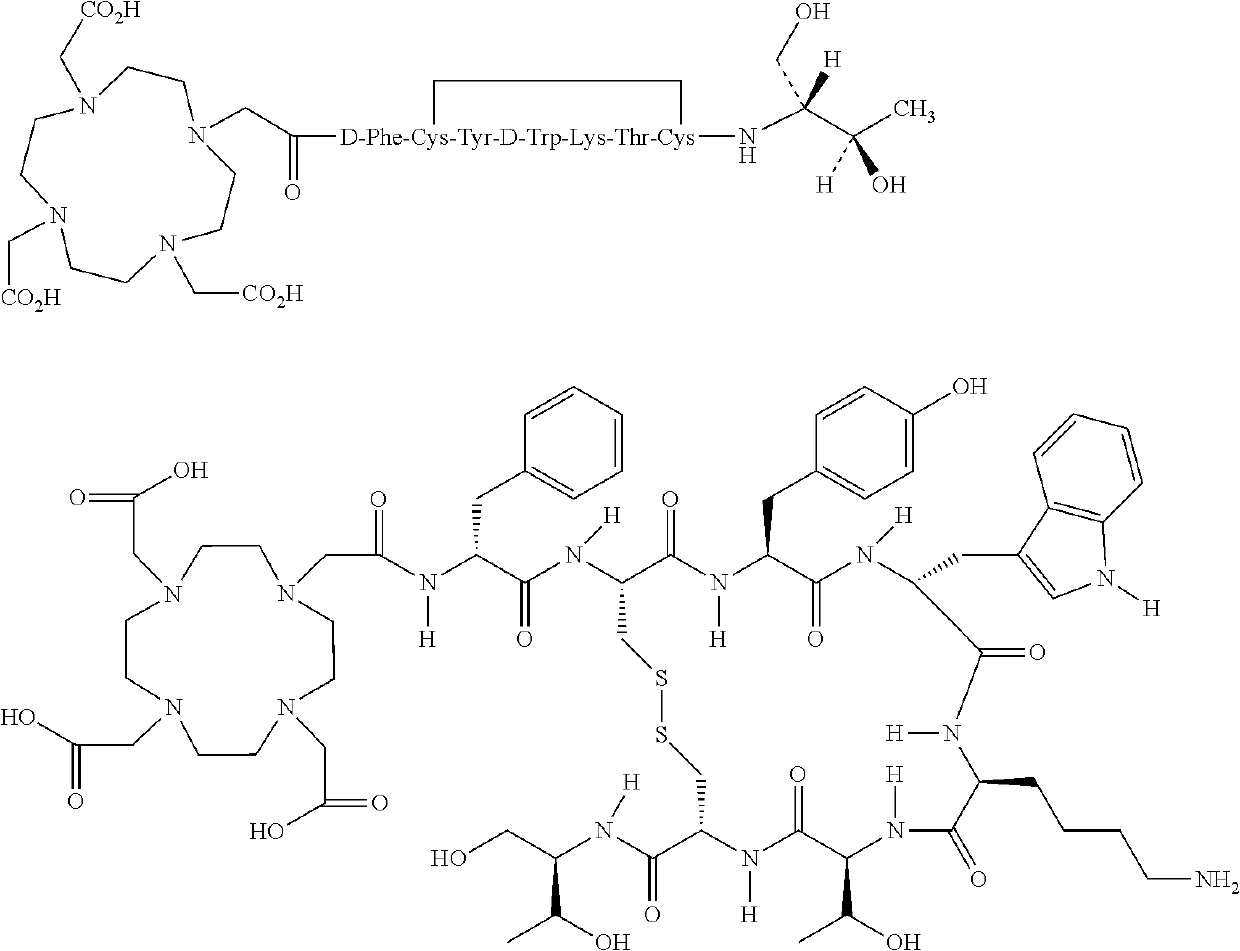Stable, concentrated radionuclide complex solutions
a radionuclide complex, concentrated technology, applied in the direction of radioactive preparation forms, pharmaceutical delivery mechanisms, therapy, etc., can solve the problems of constant decay of radionuclide, cleavage of chemical bonds, and decrease in its efficacy to act as diagnostic and/or therapeutic
- Summary
- Abstract
- Description
- Claims
- Application Information
AI Technical Summary
Benefits of technology
Problems solved by technology
Method used
Image
Examples
example 1
Composition of Drug Product
[0380]The Drug Product (177Lu-DOTA0-Tyr3-Octreotate 370 MBq / mL solution for infusion) is designed as a sterile ready-to-use solution for infusion containing 177Lu-DOTA0-Tyr3-Octreotate as Drug Substance with a volumetric activity of 370 MBq / mL at reference date and time (calibration time (tc)). Calibration time (tc) corresponds to the End of Production (EOP=t0) which is the time of measurement of the activity of the first QC vial. The shelf-life of Drug Product is defined as 72 hours after calibration time. Drug Product is a single dose vial, containing suitable amount of solution that allows delivery of 7.4 GBq of radioactivity at injection time.
[0381]Manufacturing site prepares single doses calibrated within the range of 7.4 GBq±10% (200 mCi) after the end of production. Certificates of analysis reports both the exact activity provided and the time when this activity is reached. This value is declared as “Injection time: {DD MM YYYY} {hh:mm} UTC”. Consid...
example 2
Manufacturing of Drug Product
[0383]For a 74 GBq batch size (2 Ci batch size) a 177LuCl3 solution, about 74 GBq in HCl, is mixed together with a DOTA-Tyr3-Octreotate (about 2 mg) solution, and a Reaction Buffer solution, containing an antioxidant agent (and stabilizator against radiolytic regradation) (i.e. Gentisic acid, about 157 mg) and a buffer system (i.e. Acetate buffer system), resulting in a total of about 5.5 mL solution, which is used for radiolabelling that occurs at a temperature of about 90 to about 98° C. within less than 15 minutes.
[0384]The synthesis is carried out using a single use disposable kit cassette installed on the front of the synthesis module which contains the fluid pathway (tubing), reactor vial and sealed reagent vials.
[0385]The obtained mother solution is diluted with a solution containing a chelating agent (i.e. DTPA), an antioxidant agent (i.e. Ascorbic acid) sodium hydroxide, and sodium chloride and, then sterile filtered through 0.2 μm to give the r...
example 3
Stability Study Results after Storage at Various Temperature Conditions
[0387]The following table provides the stability test data for a batch produced at 74 GBq batch size according to the process described in Example 2.
[0388]
Time points t(0) t(0 + 24 h) t(0 + 48 h) t(0 + 72 h)Stability at 5 ± 2° C. 11 mL CQ1 21.8 mLpH 5.3 n.d. n.d. 5.3 5.3Chemical purity Peptide purity (%) 100.0 n.d. n.d. 100.0 (RP-UV-HPLC) 100.0 Radiochemical 177Lu-DOTA0-Tyr3-octreotate 98.37 n.d. n.d. 96.09 purity (%)96.40 (RP-γβ-HPLC)Stability at 25 ± 2° C. 5 mL CQ1 5 mL 5 mL 24.7 mLpH 5.3 5.3 5.2 5.2 5.3Chemical purity Peptide purity (%) 100.0 100.0 100.0 100.0 (RP-UV-HPLC) Radiochemical 177Lu-DOTA0-Tyr3-octreotate 98.28 96.99 96.29 95.02 purity (%)95.62(RP-γβ-HPLC)Stability at 32 ± 2° C. 5.6 mL 5.6 mL CQ1 22.2 mL 22.2 mLpH 5.3 n.d. 5.3 n.d. 5.3Chemical purity Peptide purity (%) 100.0 100.0 100.0 n.d. (RP-UV-HPLC) 100.0 100.0 Radiochemical 177Lu-DOTA0-Tyr3-octreotate 98.37 96.03 94.45 n.d. purity (%)96.51...
PUM
| Property | Measurement | Unit |
|---|---|---|
| concentration | aaaaa | aaaaa |
| concentration | aaaaa | aaaaa |
| concentration | aaaaa | aaaaa |
Abstract
Description
Claims
Application Information
 Login to View More
Login to View More - R&D
- Intellectual Property
- Life Sciences
- Materials
- Tech Scout
- Unparalleled Data Quality
- Higher Quality Content
- 60% Fewer Hallucinations
Browse by: Latest US Patents, China's latest patents, Technical Efficacy Thesaurus, Application Domain, Technology Topic, Popular Technical Reports.
© 2025 PatSnap. All rights reserved.Legal|Privacy policy|Modern Slavery Act Transparency Statement|Sitemap|About US| Contact US: help@patsnap.com



